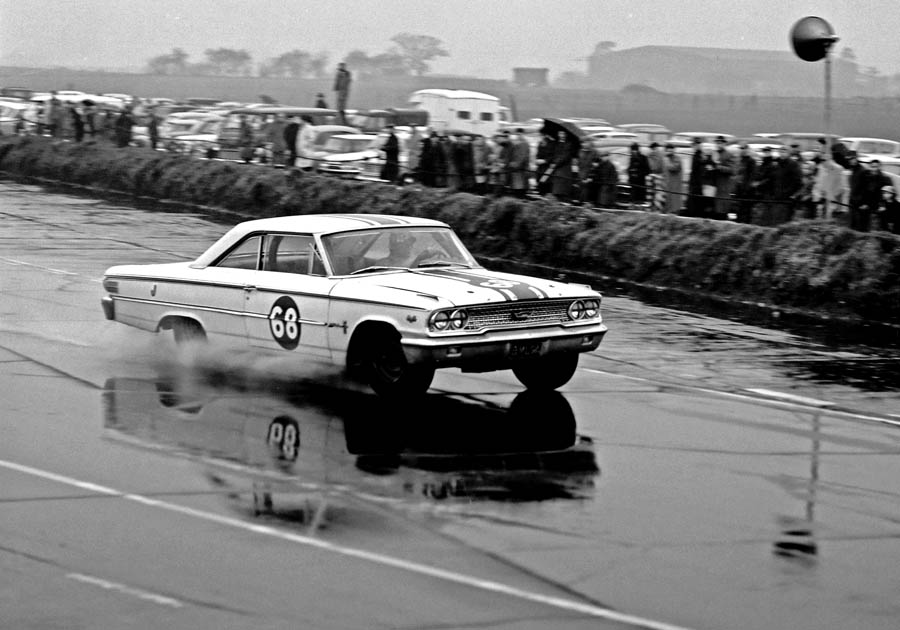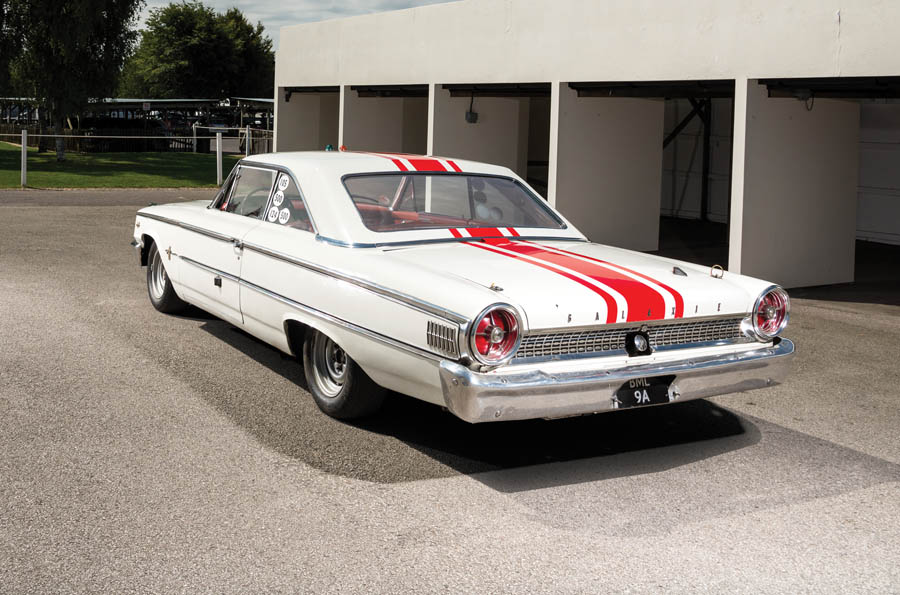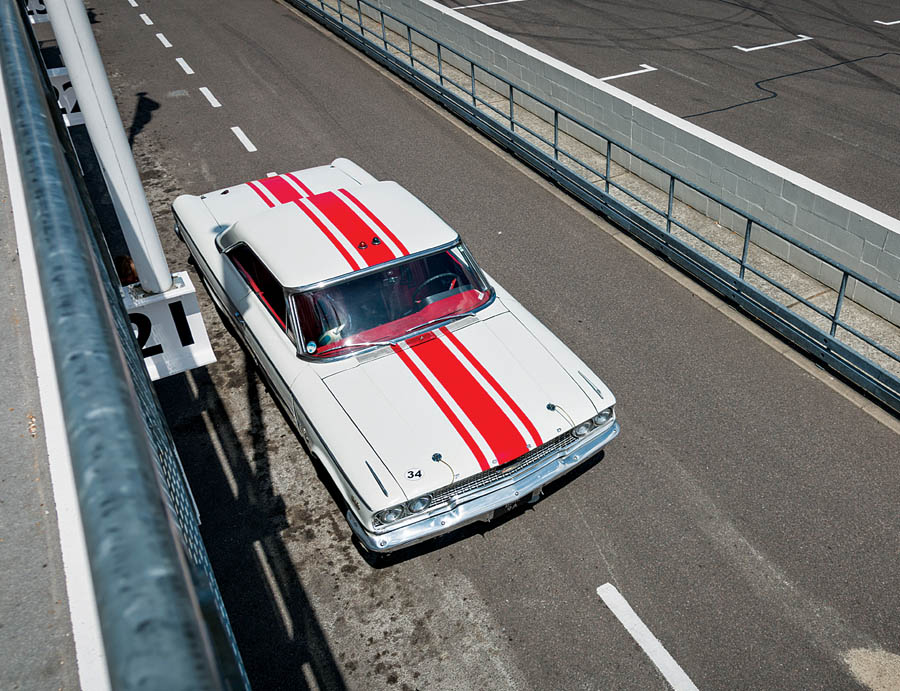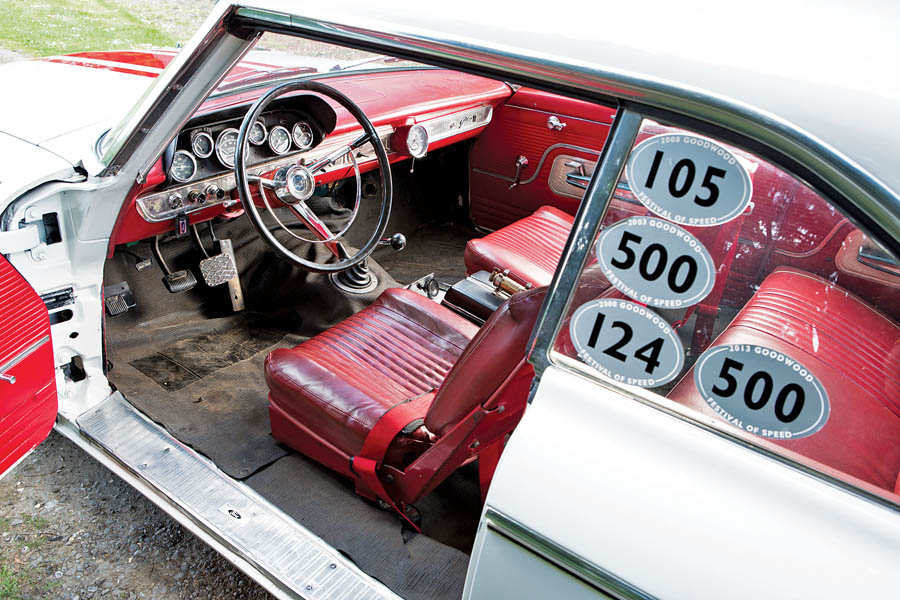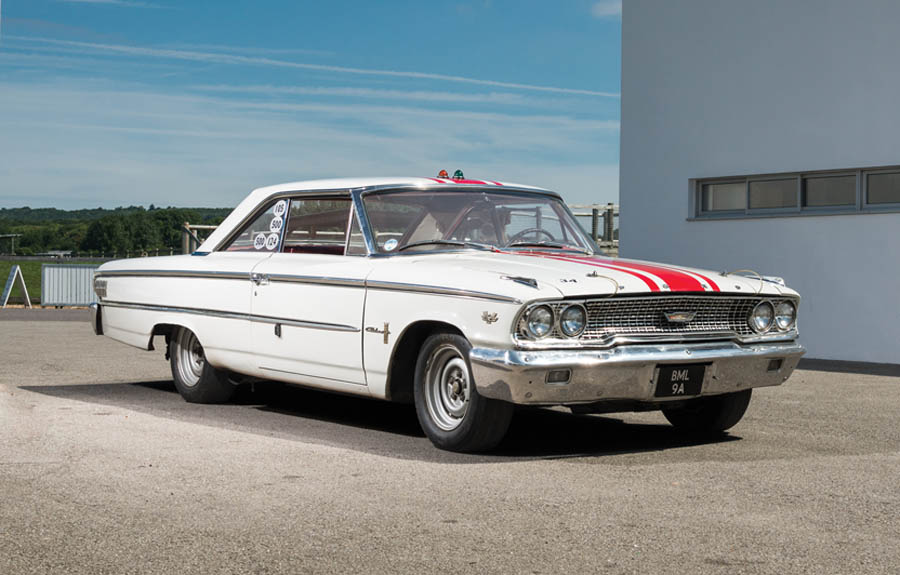Here we offer the John Willment Automobiles Ltd. racing team’s Ford Galaxie 500 — the landmark car in which the late, great, hugely popular driver Jack Sears stood the racing record on its head and shattered those long years of Jaguar domination. The Galaxie was a 400-horsepower 7-liter “Lightweight,” built by NASCAR stock-car racing specialists Holman & Moody in Charlotte, NC. It would be the first of three destined for the British saloon car-racing scene.
We commend Gentleman Jack’s 1963 Willment Ford Galaxie to the connoisseurial collectors’ market — in part as a truly historic Historic racing saloon but, most significantly, as a truly iconic and valuable landmark car hopefully to be respected, preserved and cherished for future generations to enjoy.
SCM Analysis
Detailing
| Vehicle: | 1963 Ford Galaxie 500 |
| Years Produced: | 1963 |
| Number Produced: | Three |
| Original List Price: | $3,350 |
| SCM Valuation: | $621,440 (this car) |
| Chassis Number Location: | Left door jamb |
| Alternatives: | 1960–63 Jaguar 3.8 Mk II, 1964–65 Ford Falcon Sprint, 1965–66 Shelby GT350 |
| Investment Grade: | A |
This car, Lot 217, sold for $623,561, including buyer’s premium, at the Bonhams Goodwood Revival auction in Chichester, U.K., on September 9, 2017.
Change in automobile racing is sometimes subtle and incremental, and sometimes it arrives like King Kong in New York, crashing through the old assumptions and conventions to create a new reality. This Ford Galaxie definitely represents the latter.
After this car arrived, nothing was the same in British Saloon racing, or, for that matter, road racing throughout the world.
Ripe for change
British touring-car racing was split into under-2-liter and over-2-liter classes, and though the under-2-liter group was widely competitive, the over-2-liter group had been owned exclusively by Jaguar for at least 10 years. It wasn’t so much that Jaguar was better than the competition, as that there really wasn’t anything else to run in the group.
There was an awful lot going on in 1963: Automobile racing was enjoying a surge of international popularity as the post-war boom matured. Sensing the opportunities, Ford corporate was getting back into the racing game after a very long hiatus. Firestone and Goodyear were fighting for dominance in American motorsport, and in the process were developing the revolutionary “Wide Oval” tire technology.
Though getting faster and still seriously unsafe, auto racing was still mostly amateur, and even the greatest names drove in anything they could get a ride in — saloons, Formula, endurance racing, often on the same weekend. Privateers still ran in Formula One. Commercial sponsorship was all but unknown. In hindsight, it is obvious that a huge change was about to happen.
A monster crosses the pond
In the fall of 1962, a London-based Ford dealer named John Willment decided (probably with encouragement from Ford Dearborn) that it would be both great fun and good business to form a racing team to put Ford’s best out in front of the British racing audience. English Ford’s new Lotus Cortina was sure to be a serious contender in under 2-liter. Why not try taking on Jaguar for the first-to-finish honors?
If they were going to win, the only hope was big horsepower. The mid-sized Falcon hadn’t even gotten a V8 engine yet, so the option was to go for the full-sized Galaxie 500 with its optional 427 engine and a 4-speed. Ford agreed to supply three cars for the series, the first to Willment, to see what they could do.
The 1963 Galaxie 500 was a monster compared to the Jaguars — 30 inches longer and 13 inches wider than Jag’s 3.8 Mk II — but it had been seriously developed by Holman & Moody as a NASCAR racer in the U.S. (admittedly strictly on ovals, but at least serious racing) so it wasn’t a stranger to competition, and Lord, did it have a horsepower advantage: 400 versus about 220 for the Jags.
Interestingly, in racing trim, the Ford was only about 300 pounds heavier than the Jags. Fast in a straight line was going to be a given — the real issues were going to be whether it could stop, turn and not break.
Driving honors for this first car were to be given to “Gentleman Jack” Sears, a highly competent and wildly popular Englishman who was available. Graham Hill, Roy Salvadori and other bigger-name drivers were already committed to Jaguar.
This car was flown over from the U.S. just in time to enter the BRDC May race at Silverstone. Within bounds of the possible, it was properly set up for road racing, using double shock absorbers and stiff springs at all four corners, as well as huge sway bars to keep roll under control. It retained its drum brakes and a relatively weak clutch.
Big rubber advantage
Beyond brute power, the Galaxie also had one particular advantage: tires.
Tire technology hadn’t progressed much until the early ’60s, but in the heat of competition over Indianapolis, Firestone and Goodyear had made a quantum leap: They figured out how to make a wide, low racing tire. The first ones became available in early 1963, and the Galaxie 500 was the first car to bring them to Europe.
The Jaguars ran a 15-inch-by-5-inch wide wheel and the tire had 5.5 inches of tread, while the new Firestones sat on a 15-inch-by-7-inch wide wheel and put 8 inches of tread on the ground. This was huge. It allowed far more of the available horsepower to get to the ground for acceleration and more than made up for the additional weight in the corners.
The result was that the massive, bellowing “Yank tank,” as it was derisively nicknamed, proved to be more than a match for the Jaguars. At the initial Silverstone race, Jack Sears qualified on the pole, started slowly to save the clutch, then drove past the leading Jaguars on the first big straight. After that he never even took it out of top gear, his massive horsepower advantage easily overcoming mediocre brakes and a wallowing cornering stance as he stayed comfortably ahead to take the win.
This pattern continued through the 1963 season, with Sears winning every race he finished. Two other Galaxies had arrived and were driven by Graham Hill and Jim Clark in various races. The big Fords proved unbeatable.
The basic script was repeated in 1964 with a few changes in drivers. Sears sometimes drove a Lotus Cortina in the under-2-liter class, so the monster got handed around a bit. At the end of 1964, it went to South Africa, where it continued its dominant ways and ended up staying there in the ownership of its South African driver “for old time’s sake” until 1988, when it was sold back to Jack Sears for the same sentimental reasons. He kept it for the rest of his life. His estate offered the car at this auction.
Racing legend
Ford Galaxie 500s generally are common as dirt, but this particular example is extraordinary. Both its race history and historical impact on racing are spectacular: It was the first wave of the “Yank invasion” that took over international racing in the mid-1960s. It was the introduction of the “Wide Oval” tire paradigm that changed racing forever.
Above all, it was a wonderful, anarchic poke in the eye to everything traditional — a wallowing, bellowing bull tearing up the china shop of British saloon racing. The fact that it was British-entered, driven and eventually owned by “Gentleman Jack Sears,” one of the most revered British racers of the time, only adds to its sentimental value. It is a particularly important piece of British racing legend.
In honesty, the car wouldn’t be competitive in current FIA vintage racing because it gets lumped in with the newer and far better-handling Falcons and Mustangs that followed its lead. At Goodwood, though, which is more historically inclined and limits entries to pre-1966, this car is a revered and all but guaranteed participant.
There were only three, and I am told that the others are either gone or badly compromised, while this one is highly original. It’s a lot of money for a Ford Galaxie, but wow! What a ride! Fairly bought and sold. ♦
(Introductory description courtesy of Bonhams.)
